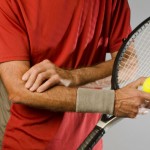

 Conditions such as tennis elbow, golfer’s elbow and cubital tunnel syndrome are common elbow pain causes. The elbow is a hinge joint located between the humerus and the upper arm. Along with the bicep muscles, the elbow allows for bending and rotating and the ligaments allow for stabilization.
Conditions such as tennis elbow, golfer’s elbow and cubital tunnel syndrome are common elbow pain causes. The elbow is a hinge joint located between the humerus and the upper arm. Along with the bicep muscles, the elbow allows for bending and rotating and the ligaments allow for stabilization.
Elbow pain can also result from arthritis, bursitis, fractures and injuries. Tennis and golfer’s elbow are more common in people who play those sports but also occur in individuals who do not. Cubital tunnel syndrome is a pain similar to hitting your “funny bone,” which is actually the ulnar nerve.
Epicondylitis – also known as medial epicondylitis or baseball or golfer’s elbow – is characterized by pain from the elbow to the wrist on the underside of the forearm. Damage to the tendons is what causes the pain sensations.
 Causes of epicondylitis are:
Causes of epicondylitis are:
Lateral epicondylitis is another form of tennis elbow, which affects the back side of the elbow and forearm along the thumb side. Damage done to the tendons that bend the wrist backwards is what causes the pain in lateral epicondylitis.
In both tennis and golfer’s elbow overuse of tendons is common, but even though the conditions may seem similar, there are many differences. The first main difference is the location of pain. In golfer’s elbow the pain occurs from the elbow down to the wrist on the underside of the forearm. In tennis elbow the pain starts from the elbow down the forearm to the thumb side of the hand.
Pain in golfer’s elbow is commonly located on the inside of the elbow, which can make bending, lifting and flexing difficult. Pain from tennis elbow is on the outside of the elbow, which can make straightening the forearm, grasping objects and straightening the wrist quite painful.
Lastly, tennis elbow is caused by the overuse of extensor muscles – those which help you extend, while golfer’s elbow is the overuse of flexor muscles – those which help you flex.
 Bursae work as tiny cushions throughout the body and reside between bones and soft tissues. Bursae contain lubricating fluids, which allow the skin to move freely on top of the bones. In the pointed part of the elbow lies the olecranon bursa, which is normally flat. If irritation occurs to the olecranon bursa, it becomes inflamed and extra fluid develops, resulting in bursitis.
Bursae work as tiny cushions throughout the body and reside between bones and soft tissues. Bursae contain lubricating fluids, which allow the skin to move freely on top of the bones. In the pointed part of the elbow lies the olecranon bursa, which is normally flat. If irritation occurs to the olecranon bursa, it becomes inflamed and extra fluid develops, resulting in bursitis.
Bursitis is caused by the following:
Symptoms of bursitis involve swelling and pain. If swelling is severe, it can actually limit elbow mobility and range of motion. Pain may worsen if pressure is added to the elbow, and if caused by infection, redness may occur as well.
There are non-surgical treatments for bursitis, including elbow pads, changes to activity and medications to combat inflammation and pain.
Surgical treatments may involve removing excess fluid or removing the bursa completely, depending on severity. A splint may be required for proper recovery post-surgery.
 Cubital tunnel syndrome – or ulnar nerve entrapment at the elbow – is a condition where the ulnar nerve becomes compressed or irritated. The ulnar nerve is one of the three main nerves that run in the arm. It begins in the neck and follows through to the hand. There are many areas where the ulnar nerve can become compressed, for example, the collar bone, but the elbow is the most common location.
Cubital tunnel syndrome – or ulnar nerve entrapment at the elbow – is a condition where the ulnar nerve becomes compressed or irritated. The ulnar nerve is one of the three main nerves that run in the arm. It begins in the neck and follows through to the hand. There are many areas where the ulnar nerve can become compressed, for example, the collar bone, but the elbow is the most common location.
Compression of the ulnar nerve can lead to tingling or numbness in the hands or fingers.
Common causes of cubital tunnel syndrome are:
Risk factors for cubital tunnel syndrome are:
Arthritis can affect all the joints in the body, elbows included. Arthritis in the elbow can cause pain when the elbow is bent or even straightened. Rheumatoid arthritis specifically causes the cartilage between the bones to wear away. Osteoarthritis can also affect the cushioning between joints, leading to pain when moving the elbow.
Symptoms of arthritis in the elbow include:
If you’re concerned about pain in your elbow, speak with your doctor as they can rule out which condition is causing you discomfort and advise the best course of treatment.
Tennis elbow: Natural treatment, causes, symptoms and prevention
Tennis elbow, or lateral epicondylitis, is a condition that encompasses the overuse of the forearm, arm and hand muscles, which creates elbow pain. Although it is commonly referred to as tennis elbow, it is not only experienced by tennis players; the term only came about because the condition was quite common among tennis players. Continue reading…
Do these 7 things to live life without pain
Throughout the course of our lives we have all experienced pain. Whether due to injury or illness, we all have felt pain. But shocking numbers now reveal that over 25 million Americans suffer from chronic pain. Continue reading…
Copyright © www.orthopaedics.win Bone Health All Rights Reserved